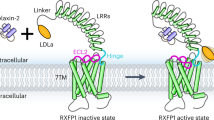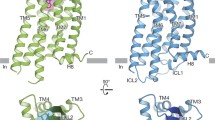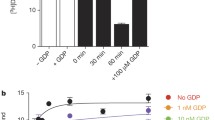Abstract
PEPTIDE hormones, neurotransmitters, and autacoids activate a family of seven-transmembrane-domain receptors1. Each of these receptors specifically couples to one of several G proteins, Gs, Gi, Go and Gp, to activate a specific second messenger system2. Cell surface receptors for prostanoids have been characterized pharmacologically3 and the complementary DNAs for thrombox-ane A2 receptor4,5 and the EP3 subtype of the prostaglandin (PG)E receptor6 reveal that they belong to the seven-transmembrane-domain receptor family. The EP3 receptor mediates the diverse physiological actions of PGE2 (ref. 3). Although most of them occur through coupling of the EP3 receptor to Gi and inhibition of adenylyl cyclase, the EP3-mediated contraction of uterine muscle can only occur by activation of another second messenger pathway7. In chromaffin cells, two different second messenger pathways are activated by PGE2 binding to an apparently single EP3 receptor class8. Here we show that at least four isoforms of the EP3 receptor, which differ only at their C-terminal tails and are produced by alternative splicing, couple to different G proteins to activate different second messenger systems.
Similar content being viewed by others
References
O'Dowd, B. F., Lefkowitz, R. J. & Caron, M. G. A. Rev. Neurosci. 12, 67–83 (1989).
Gilman, A. G. A. Rev. Biochem. 56, 615–649 (1987).
Coleman, R. A., Kennedy, I., Humphrey, P. P. A., Bunce, K. & Lumley, P. in Comprehensive Medicinal Chemistry Vol. 3 (ed. Emmett, J. C.) 643–714 (Pergamon, Oxford, 1990).
Hirata, M. et al. Nature 349, 617–620 (1991).
Namba, T. et al. Biochem. biophys. Res. Commun. 184, 1197–1203 (1992).
Sugimoto, Y. et al. J. biol. Chem. 267, 6463–6466 (1992).
Goureau, O., Tanfin, Z., Marc, S. & Harbon, S. Am. J. Physiol. 263, C257–C265 (1992).
Negishi, M., Ito, S. & Hayaishi, O. J. biol. Chem. 264, 3916–3923 (1989).
Padgett, R. A., Grabowski, P. J., Konarska, M. M., Seiler, S. & Sharp, P. A. A. Rev. Biochem. 55, 1119–1150 (1986).
Negishi, M. et al. J. biol. Chem. 262, 12077–12084 (1987).
Federman, A. D., Conklin, B. R., Schrader, K. A., Reed, R. R. & Bourne, H. R. Nature 356, 159–161 (1992).
O'Dowd, B. F. et al. J. biol. Chem. 263, 15985–15992 (1988).
Hausdorff, W. P., Hnatowich, M., O'Dowd, B. F., Caron, M. G. & Lefkowitz, R. J. J. biol. Chem. 265, 1388–1393 (1990).
Franke, R. R., König, B., Sakmar, T. P., Khorana, H. G. & Hofmann, K. P. Science 250, 123–125 (1990).
Okamoto, T. et al. Cell 67, 723–730 (1991).
Okamoto, T. & Nishimoto, I. J. biol. Chem. 267, 8342–8346 (1992).
Ikezu, T., Okamoto, T., Ogata, E. & Nishimoto, I. FEBS Lett. 311, 29–32 (1992).
Cotecchia, S., Exum, S., Caron, M. G. & Lefkowitz, R. J. Proc. natn. Acad. Sci. U.S.A. 87, 2896–2900 (1990).
O'Dowd, B. F., Hnatowich, M., Caron, M. G., Lefkowitz, R. J. & Bouvier, M. J. biol. Chem. 264, 7564–7569 (1989).
Giros, B. et al. Nature 342, 923–926 (1989).
Monsma, F. J., McVittie, L. D., Gerfen, C. R., Mahan, L. C. & Sibley, D. R. Nature 342, 926–929 (1989).
Dal Toso, R. et al. EMBO J. 8, 4025–4034 (1989).
Tanabe, Y., Masu, M., Ishii, T., Shigemoto, R. & Nakanishi, S. Neuron 8, 169–179 (1992).
Fong, T. M., Anderson, S. A., Yu, H., Huang, R.-R. C. & Strader, C. D. Molec. Pharmac. 41, 24–30 (1992).
Sugimoto, Y. et al. J. biol. Chem. 268, 2712–2718 (1993).
Kyte, J. & Doolittle, R. F. J. molec. Biol. 157, 105–132 (1982).
Oikawa, S. et al. Biochem. biophys. Res. Commun. 164, 39–45 (1989).
Felgner, P. L. et al. Proc. natn. Acad. Sci. U.S.A. 84, 7413–7417 (1987).
Okajima, F., Katada, T. & Ui, M. J. biol. Chem. 260, 6761–6768 (1985).
Ito, S. et al. J. Neurochem. 56, 531–540 (1991).
Author information
Authors and Affiliations
Rights and permissions
About this article
Cite this article
Namba, T., Sugimoto, Y., Negishi, M. et al. Alternative splicing of C-terminal tail of prostaglandin E receptor subtype EP3 determines G-protein specificity. Nature 365, 166–170 (1993). https://doi.org/10.1038/365166a0
Received:
Accepted:
Issue Date:
DOI: https://doi.org/10.1038/365166a0
- Springer Nature Limited
This article is cited by
-
Prostaglandin E2 sensitizes the cough reflex centrally via EP3 receptor-dependent activation of NaV 1.8 channels
Respiratory Research (2021)
-
mPGES-1/PGE2 promotes the growth of T-ALL cells in vitro and in vivo by regulating the expression of MTDH via the EP3/cAMP/PKA/CREB pathway
Cell Death & Disease (2020)
-
The Regulation of Uterine Function During Parturition: an Update and Recent Advances
Reproductive Sciences (2020)
-
COX-2-PGE2-EPs in gynecological cancers
Archives of Gynecology and Obstetrics (2020)
-
Role of cyclooxygenase-2-mediated prostaglandin E2-prostaglandin E receptor 4 signaling in cardiac reprogramming
Nature Communications (2019)





